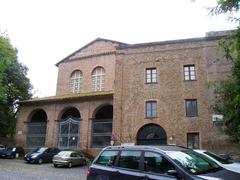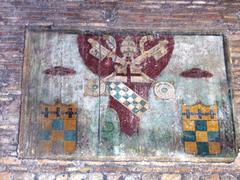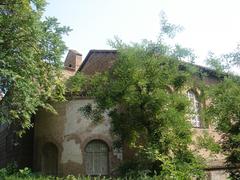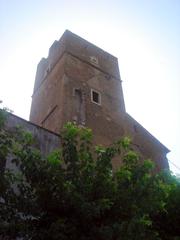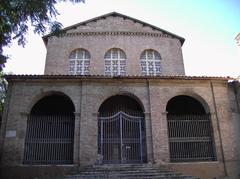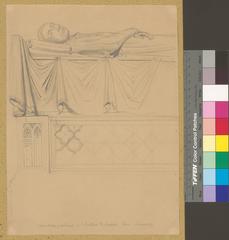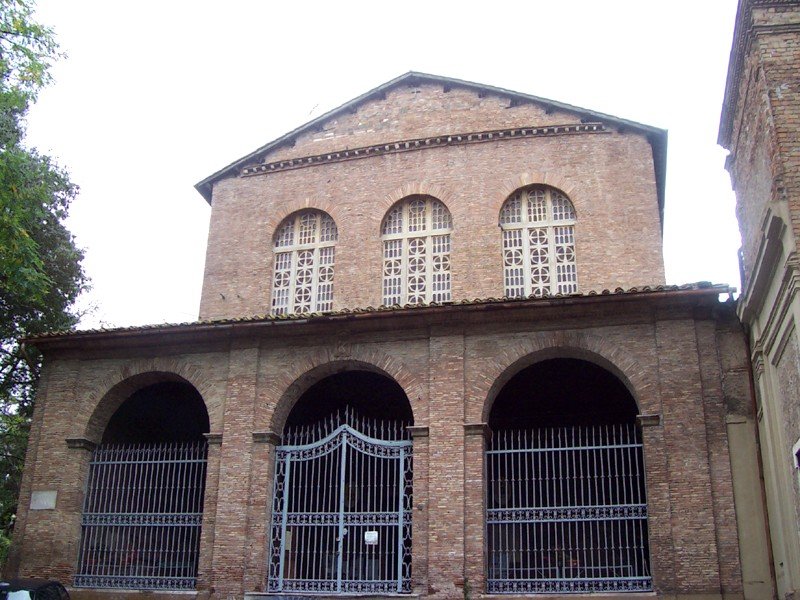
Santa Balbina Rome Visiting Hours Tickets and Historical Sites Guide
Date: 14/06/2025
Introduction to Santa Balbina in Rome including its history and cultural significance
Nestled amidst the historic Aventine Hill in Rome, the Basilica di Santa Balbina stands as a captivating yet often overlooked treasure of early Christian heritage and Roman architectural ingenuity. This serene basilica, dating back to the late 4th or early 5th century, is dedicated to Saint Balbina, a 2nd-century virgin martyr whose relics are believed to rest beneath its altar. The basilica’s foundation atop the Roman domus of Lucius Fabius Cilo—an imperial consul—adds a profound layer of historical significance, symbolizing Rome’s transformative journey from imperial grandeur to Christian sanctity.
Visitors to Santa Balbina are treated to an authentic glimpse of early Christian basilica architecture, characterized by its spacious nave flanked by aisles supported by ancient granite columns, complemented by medieval cosmatesque mosaics and evocative frescoes by artists like Anastasio Fontebuoni. The austere brick façade, medieval bell tower, and interior artistic treasures reflect centuries of architectural evolution and devotion, from the 8th-century roof reconstruction under Pope Leo III to 17th-century Baroque embellishments.
Beyond its architectural and artistic importance, Santa Balbina has played a continuous role in Rome’s religious life as a cardinal titular church and a locus of pilgrimage, social outreach, and spiritual reflection. Managed today by the Franciscan Sisters of the Sacred Hearts, the basilica also embodies a living tradition of charity and community service.
This comprehensive guide provides essential visiting information including hours, ticketing (notably free admission), accessibility details, and travel tips for reaching the basilica. It further explores nearby historical sites such as the Basilica of Santa Sabina, the Orange Garden, and the Baths of Caracalla, inviting visitors to immerse themselves in the rich tapestry of Rome’s Aventine Hill. For those seeking a peaceful, reflective experience away from the bustling city center, Santa Balbina offers a profound encounter with Rome’s layered history and enduring spiritual heritage.
For detailed insights and updates on visiting Santa Balbina, refer to trusted sources such as Turismo Roma, Roman Churches Fandom, and CatholicSaints.day.
Table of Contents covering visiting hours tickets travel tips nearby attractions and accessibility
- Introduction
- Historical Overview
- Origins and Early Christian Foundations
- Recognition and Ecclesiastical Importance
- Architectural Evolution and Artistic Highlights
- Dedication to Saint Balbina: Legend and Patronage
- Role in Early Christian Rome and Pilgrimage
- Artistic and Liturgical Heritage
- Monastic and Social Outreach
- Visiting Information
- Opening Hours
- Tickets
- Guided Tours
- Accessibility
- Travel Tips
- Architectural Features and Artistic Highlights
- Exterior Architecture
- Interior Structure and Elements
- Nave and Columns
- Apse and Sanctuary
- Side Chapels and Artworks
- Artistic Highlights
- Frescoes and Mosaics
- Sculptural Elements
- Notable Relics and Liturgical Objects
- Restoration and Preservation
- Visitor Information
- Visiting Hours and Tickets
- Accessibility
- Guided Tours and Special Events
- Best Photographic Spots
- Tips for Visitors
- Santa Balbina Visiting Hours, Tickets, and Tips
- Location and Access
- Directions
- Visiting Hours and Ticket Information
- What to Expect During Your Visit
- Visitor Tips
- Nearby Attractions
- Frequently Asked Questions (FAQ)
- Plan Your Visit with Audiala
- Conclusion and Call to Action
- Additional Resources
Visiting Basilica di Santa Balbina in Rome: History, Hours, Tickets & Travel Tips
Introduction
Nestled on the historic Aventine Hill, the Basilica di Santa Balbina is one of Rome’s lesser-known but richly historic churches. Offering visitors a blend of ancient Roman foundations, early Christian architecture, and Baroque artistry, it stands as a serene and captivating site among Rome historical sites. Whether you are a history enthusiast, an art lover, or a pilgrim, Santa Balbina invites you to explore its unique heritage.
Historical Overview
Origins and Early Christian Foundations
The Basilica di Santa Balbina all’Aventino dates back to the late 5th or early 6th century CE. Dedicated to Saint Balbina, a Christian martyr from the 3rd century, the basilica symbolizes resilience and devotion. It was built atop the Roman domus of Lucius Fabius Cilo, a consul granted the property by Emperor Septimius Severus. Visitors can still see remnants of the original Roman walls in the garden of the adjacent Ospizio di Santa Margherita.
Recognition and Ecclesiastical Importance
First documented in 595 CE as a cardinal titular church, Santa Balbina played a key role in Rome’s ecclesiastical hierarchy during the early Middle Ages. Despite hardships during barbarian invasions, it remained a spiritual anchor on the Aventine Hill.
Architectural Evolution and Artistic Highlights
The basilica showcases early Christian basilica design with a longitudinal nave flanked by chapels. Key restorations include the 8th-century roof reconstruction by Pope Leo III and 16th-century façade renovations. The 17th century brought Baroque enhancements, most notably the apse frescoes by Anastasio Fontebuoni depicting the Glory of Christ and saints. The 13th-century Cosmatesque episcopal throne is a highlight for art and history buffs.
Visiting Information
Opening Hours
- Monday to Saturday: 9:00 AM – 12:30 PM and 4:00 PM – 6:00 PM
- Sunday and Public Holidays: 10:00 AM – 1:00 PM (Please check official sources before your visit as hours may vary.)
Tickets
Admission to the Basilica di Santa Balbina is free. Donations are welcome to support maintenance and restoration efforts.
Guided Tours
Guided tours are occasionally available through local tour operators focusing on Rome historical sites and early Christian churches. Visitors interested in a guided experience should book in advance.
Accessibility
The basilica is accessible to visitors with reduced mobility, though some uneven flooring and steps may be present due to the ancient structure.
Travel Tips
- The basilica is best reached via the Circo Massimo Metro Station (Line B), followed by a 10-minute walk.
- Wear comfortable shoes due to cobblestone streets in the Aventine neighborhood.
- Visit early in the day or late afternoon to avoid crowds and enjoy a peaceful atmosphere.
Nearby Attractions
- Basilica of Santa Sabina, also on Aventine Hill
- Orange Garden (Giardino degli Aranci) for panoramic views of Rome
- Circo Massimo and Palatine Hill are within walking distance
Photography and Special Features
The basilica’s understated exterior contrasts with its richly decorated interior, providing excellent photographic opportunities especially of the apse frescoes and Cosmatesque throne. The tranquil garden offers a peaceful spot for reflection and photos.
Frequently Asked Questions (FAQ)
Q: What are the visiting hours of Basilica di Santa Balbina? A: The basilica is generally open Monday to Saturday from 9:00 AM to 12:30 PM and 4:00 PM to 6:00 PM, and Sundays from 10:00 AM to 1:00 PM.
Q: Is there an entrance fee? A: No, admission is free.
Q: Are guided tours available? A: Guided tours can be arranged through local tour companies; advance booking is recommended.
Q: Is the basilica accessible for people with disabilities? A: Yes, though some ancient architectural features may present minor challenges.
Q: How do I get to the Basilica di Santa Balbina? A: The closest Metro station is Circo Massimo (Line B), followed by a short walk.
Conclusion
The Basilica di Santa Balbina offers a unique glimpse into Rome’s layered history, from ancient Roman roots to early Christian worship and Baroque artistry. Its quiet location on the Aventine Hill makes it a perfect stop for visitors seeking a peaceful and enriching experience away from the bustling city center.
Plan Your Visit
To make the most of your trip, check the official basilica website or trusted Rome travel resources for the latest visiting hours and events. Consider combining your visit with nearby historical sites to fully enjoy the Aventine Hill’s charm.
Additional Resources
Call to Action
Discover more hidden gems like the Basilica di Santa Balbina by downloading the Audiala app for curated Rome travel guides and updates. Follow us on social media for daily tips and exclusive offers to enhance your Roman adventure!
Introduction
Nestled on the serene Aventine Hill, the Basilica of Santa Balbina is a hidden gem among Rome’s historic religious sites. This article explores Santa Balbina’s rich religious and cultural heritage, practical visitor information including visiting hours and ticketing, and tips to make the most of your visit to this captivating basilica. Whether you’re a pilgrim, history enthusiast, or traveler seeking tranquility away from the bustling city center, Santa Balbina offers a unique window into Rome’s early Christian past.
Dedication to Saint Balbina: Legend and Patronage
Santa Balbina is dedicated to Saint Balbina, a 2nd-century Roman virgin and martyr. Tradition holds that she was the daughter of Quirinus, a Roman tribune who converted to Christianity. Both reportedly suffered martyrdom around 130 CE. Her relics are believed to rest beneath the basilica, making it a pilgrimage site for spiritual intercession (Turismo Roma; Christianedirectory).
She is also venerated as the patron saint of those afflicted with scrofula, a disease once widespread, reflecting medieval traditions of seeking saintly healing (Roman Churches Fandom). The church’s dedication symbolizes both early Christian martyrdom and enduring hope for healing.
Role in Early Christian Rome and Pilgrimage
Founded in the late 4th or early 5th century atop the house of Lucius Fabius Cilo, a Roman consul, Santa Balbina marks Rome’s transformation from imperial capital to Christian center (Wikipedia; Belvicci). It may correspond to the ancient “titulus Tigridae,” linking it to the earliest Roman house-churches.
As a minor basilica and titular church, assigned to a cardinal-priest, it remains an active spiritual hub, consecrated by Pope Gregory III in the 8th century (Roman Churches Fandom).
Artistic and Liturgical Heritage
Inside, visitors encounter Baroque frescoes by Anastasio Fontebuoni (1599) adorning the apse and triumphal arch, illustrating scenes from Christ and the Virgin Mary’s lives (Belvicci). The basilican plan and brickwork preserve early Christian architecture alongside Renaissance and Baroque additions, reflecting evolving devotional practices (Christianedirectory).
Monastic and Social Outreach
Historically linked to Augustinians and later secular priests from Naples, Santa Balbina today benefits from the Franciscan Sisters of the Sacred Hearts (Margheritine Sisters). Under Father Simpliciano della Natività, they manage St. Margaret’s facility to support women exploited through prostitution (Turismo Roma). This highlights the church’s ongoing commitment to charity and social justice.
Visiting Santa Balbina: Hours, Tickets, and Tips
- Visiting Hours: Santa Balbina is generally open to visitors from 9:00 AM to 12:00 PM and 4:00 PM to 6:00 PM daily. However, hours may vary during religious holidays or special events.
- Tickets: Entrance is free, but donations are welcome to support maintenance and social programs.
- Accessibility: The basilica is wheelchair accessible, with ramps available at the main entrance.
- Guided Tours: While no official guided tours are regularly scheduled, private guides and group tours can be arranged through local agencies. Audio guides may be available via mobile apps.
- Photography: Visitors are welcome to take photos inside, but flash photography is discouraged to preserve the artwork.
- Nearby Attractions: The basilica is close to the Baths of Caracalla and the Orange Garden (Giardino degli Aranci), perfect for combining historical sightseeing with leisurely walks.
Liturgical Life and Contemporary Spirituality
Santa Balbina continues to serve as a place of worship, with regular Masses and Eucharistic adoration fostering a serene atmosphere (Roman Churches Fandom). Its open-door policy invites both worshippers and tourists to pause for reflection away from central Rome’s crowds (Christianedirectory).
During special occasions like the Vatican Jubilee Year, it becomes a meaningful stop for pilgrims seeking to connect deeper with Rome’s Christian heritage (Roma Pass).
Cultural Significance and Community Identity
Located in a historic district near the Baths of Caracalla, Santa Balbina offers a peaceful contrast to Rome’s bustling tourist spots. It serves as a neighborhood parish and a symbol of the Aventine Hill’s layered history—from imperial residences to Christian sanctuaries (Christianedirectory).
The basilica hosts cultural events, religious festivals, and educational activities, fostering community identity and continuity.
Interfaith and Intercultural Dimensions
Santa Balbina embodies the dialogue between ancient Roman pagan culture and Christianity, reflected in its architecture and art. Its commitment to social outreach resonates with universal values, welcoming visitors of all backgrounds.
Pilgrimage, Reflection, and Modern Relevance
For modern pilgrims and tourists, Santa Balbina offers intimate engagement with Rome’s spiritual and cultural legacy. Its association with martyrdom, healing, and charity provides a meaningful framework for personal reflection (Christianedirectory; Roman Churches Fandom).
Visuals and Media
Visitors can find high-quality images and virtual tours of Santa Balbina on official tourism websites and cultural heritage platforms. Here is a map to help locate the basilica easily within Rome.
Frequently Asked Questions (FAQ)
Q: What are Santa Balbina’s visiting hours? A: Typically 9:00 AM to 12:00 PM and 4:00 PM to 6:00 PM daily, but check locally for changes.
Q: Is there an entrance fee? A: Entrance is free; donations are appreciated.
Q: Are guided tours available? A: Official tours are not regularly scheduled, but private tours can be arranged.
Q: Is the basilica wheelchair accessible? A: Yes, ramps and accessible entrances are available.
Q: Can I take photographs inside? A: Yes, but flash photography is discouraged.
Conclusion
Santa Balbina Basilica is a remarkable blend of historical depth, religious significance, artistic heritage, and social commitment. Whether you’re visiting for spiritual reasons, historical interest, or cultural exploration, the basilica invites you to experience a quieter, profound side of Rome. Plan your visit with the practical tips provided, and immerse yourself in the rich legacy that continues to inspire.
For more travel inspiration and updates on Rome’s historical sites, download the Audiala app, explore related posts on our website, and follow us on social media. Your journey to uncover Rome’s hidden treasures starts here!
Architectural Features and Artistic Highlights of Santa Balbina
Historical Context and Layout
Santa Balbina stands as one of Rome’s lesser-known but historically significant early Christian churches, located on the Aventine Hill. The basilica is believed to have been constructed in the 4th century, possibly over the house of the Roman tribune Quirinus, father of Saint Balbina, whose life and martyrdom are closely tied to the site (CatholicSaints.day). The church’s original structure has undergone several restorations, most notably in the 13th and 17th centuries, but it retains much of its early Christian basilica character.
The basilica’s plan follows the traditional Roman basilica layout: a rectangular nave flanked by two aisles, separated by rows of ancient columns, and terminating in a semicircular apse. The nave is notably wide and airy, with high clerestory windows that allow natural light to illuminate the interior, a hallmark of early Christian architecture designed to evoke spiritual transcendence.
Exterior Architecture
The façade of Santa Balbina is relatively austere compared to Rome’s more ornate churches. It features a simple brickwork design, reflecting its early Christian origins and the modesty associated with the saint herself. The entrance is preceded by a portico, which was added in the 13th century and is supported by repurposed ancient columns, a common practice in Roman ecclesiastical architecture.
Above the entrance, a modest bell tower rises, dating from the medieval period. The tower’s brick construction and small arched windows are typical of Romanesque architecture, blending harmoniously with the basilica’s overall simplicity.
Interior Structure and Elements
Nave and Columns
Upon entering, visitors are greeted by a spacious nave lined with 18 ancient granite columns, believed to have been sourced from earlier Roman buildings. These columns support a series of arches, creating a rhythmic visual progression toward the apse. The capitals of the columns are a mix of Corinthian and Ionic styles, some of which are spolia—reused from classical Roman structures—demonstrating the adaptive reuse that characterizes much of Rome’s ecclesiastical architecture.
The nave’s wooden truss ceiling, restored in the 20th century, preserves the open, unadorned look typical of early Christian basilicas. The floor is paved with cosmatesque mosaics, a geometric inlay style popular in medieval Rome, adding a layer of artistic richness to the otherwise restrained interior.
Apse and Sanctuary
The focal point of the church is the semicircular apse, which houses the high altar and the relics of Saint Balbina. The apse is adorned with a 13th-century fresco cycle depicting Christ the Redeemer, flanked by saints and angels. Although the frescoes have suffered from centuries of wear, their faded beauty offers a glimpse into the medieval artistic sensibility and the devotional atmosphere of the period.
Beneath the altar lies the confessio, a small crypt area traditionally believed to contain the remains of Saint Balbina and her father, Quirinus. This sacred space is a site of pilgrimage, especially on the saint’s feast day, March 31 (CatholicSaints.day).
Side Chapels and Artworks
The basilica contains several side chapels, each with its own artistic highlights. Notably, the Chapel of Saint Balbina features a 17th-century altarpiece depicting the saint in prayer, surrounded by scenes from her life. The painting emphasizes her virtues of faith, courage, and purity, which are central to her veneration (CatholicSaints.day).
Other chapels house works from various periods, including Renaissance and Baroque paintings, though the overall decorative scheme remains subdued compared to Rome’s grander churches. This restraint is intentional, reflecting the early Christian emphasis on spiritual contemplation over visual opulence.
Artistic Highlights
Frescoes and Mosaics
The most significant artistic feature of Santa Balbina is its apse fresco, attributed to the school of Pietro Cavallini, a leading Roman painter of the late 13th century. The fresco depicts Christ in Majesty, seated on a throne, with the Virgin Mary, Saint Peter, Saint Paul, and Saint Balbina herself in attendance. The composition is notable for its solemnity and the use of gold backgrounds, which were intended to evoke the heavenly realm.
Fragments of earlier frescoes can be found throughout the nave and aisles, some dating back to the 9th and 10th centuries. These include depictions of biblical scenes and saints, rendered in the stylized manner characteristic of early medieval Roman art.
The cosmatesque floor mosaics, with their intricate geometric patterns of colored marble and glass, are another highlight. These mosaics were crafted by the Cosmati family, renowned for their decorative stonework in Roman churches during the 12th and 13th centuries. The floor’s vibrant patterns contrast with the otherwise muted palette of the interior, drawing the eye and inviting closer inspection.
Sculptural Elements
While Santa Balbina is not known for an abundance of sculpture, it does feature several noteworthy pieces. The main altar is supported by a sculpted marble base, possibly dating from the early medieval period. In the sacristy, visitors can find a collection of ancient sarcophagi and fragments of Roman funerary art, some of which are believed to have been repurposed from the original burial site of Saint Balbina.
The church’s wooden choir stalls, carved in the Renaissance period, display delicate intaglio work and serve as a reminder of the basilica’s continuous use and adaptation over the centuries.
Notable Relics and Liturgical Objects
Santa Balbina is reputed to house several important relics, most notably those of Saint Balbina herself. According to tradition, her remains were interred here after her martyrdom in the 2nd century (CatholicSaints.day). The church also preserves relics associated with her father, Quirinus, and other early Christian martyrs.
Among the liturgical treasures are a silver reliquary, used during the annual feast day celebrations, and a collection of medieval chalices and vestments displayed in the sacristy. These objects, though not always on public view, underscore the church’s enduring role as a center of devotion and pilgrimage.
Restoration and Preservation
Santa Balbina has undergone several phases of restoration, most notably in the 13th century under Pope Honorius III and again in the 20th century. These efforts have focused on stabilizing the ancient structure, conserving the frescoes, and preserving the cosmatesque floor. The basilica’s relatively unaltered state makes it a valuable example of early Christian architecture in Rome, offering insights into the city’s religious and artistic evolution.
Visitor Information for Santa Balbina
Visiting Hours and Tickets
Santa Balbina is generally open to visitors from 9:00 AM to 12:30 PM and from 3:00 PM to 6:00 PM daily, although hours can vary during religious holidays or special events. Admission is free, but donations are welcomed to support preservation efforts. Visitors seeking to attend Mass or special liturgical celebrations should check the church’s schedule in advance.
Accessibility
The basilica is partially accessible to visitors with mobility impairments; however, some areas, such as the confessio and crypt, may have limited access due to historic staircases and narrow passages. Assistance can often be arranged by contacting the parish office ahead of your visit.
Guided Tours and Special Events
Guided tours focusing on the architectural and artistic heritage of Santa Balbina are offered by several local tour operators and can be booked online or through visitor centers in Rome. The church also hosts special events on the feast day of Saint Balbina (March 31), including processions and devotional ceremonies.
Best Photographic Spots
Photographers will find the nave’s ancient granite columns and the apse fresco particularly compelling subjects. The cosmatesque floor mosaics provide intricate detail shots, while the basilica’s location on the Aventine Hill offers scenic views of Rome’s skyline. Visitors are reminded to respect the sanctity of the space and avoid flash photography during services.
Tips for Visitors
- Modest dress is required: shoulders and knees should be covered (RomeCabs). A light scarf or shawl is recommended during warmer months.
- Photography is generally permitted outside of liturgical services.
- Plan your visit in conjunction with nearby sites such as the Basilica of Santa Sabina and the Orange Garden for a comprehensive historical experience.
Related Articles
Frequently Asked Questions (FAQ) about Visiting Santa Balbina
Q: Is there an entrance fee to visit Santa Balbina? A: No, admission is free, but donations are appreciated.
Q: What are the opening hours of Santa Balbina? A: Typically, 9:00 AM to 12:30 PM and 3:00 PM to 6:00 PM daily; hours may vary on holidays.
Q: Are guided tours available? A: Yes, guided tours can be booked through local operators or visitor centers.
Q: Is Santa Balbina wheelchair accessible? A: Partial accessibility is available; some areas may be challenging due to historic architecture.
Q: Can I take photographs inside the church? A: Photography is generally allowed outside of Mass and services; flash photography is discouraged.
For further details on Santa Balbina’s history, significance, and visitor information, see CatholicSaints.day.
Plan Your Visit with Audiala
Discover more about Rome’s hidden historical gems like Santa Balbina with the Audiala app. Download today for expert audio guides, personalized tours, and the latest updates on visiting hours and special events. Follow us on social media for travel tips and exclusive content!
Santa Balbina Visiting Hours, Tickets, and Tips for Exploring Rome’s Historic Aventine Basilica
Meta Description: Discover essential information for visiting Santa Balbina, including visiting hours, ticket details, accessibility, and tips for exploring one of Rome’s historic Aventine basilicas.
Introduction
Nestled on Rome’s serene Piccolo Aventino (Little Aventine Hill), the Basilica of Santa Balbina is a hidden gem rich in history and spirituality. This guide provides all the practical details you need for your visit — from Santa Balbina visiting hours and ticket information to directions, nearby attractions, and insider tips for making the most of your experience at this remarkable Rome historical site.
Location and Access
Santa Balbina is located in the San Saba district of Rome at the end of an ancient walled street, preserving its historic charm. The main modern entrance is on Via Baccelli, accessed via the staircase dedicated to Padre Simpliciano della Natività, founder of the Suore Francescane dei Sacri Cuori (Franciscan Sisters of the Sacred Hearts). Its proximity to the Baths of Caracalla and Stadio delle Terme makes it an ideal stop when exploring Rome’s Aventine Hill area.
Directions
- By Metro: The nearest station is Circo Massimo on Line B, about a 10-minute walk.
- By Bus: Multiple city buses serve the nearby Via delle Terme di Caracalla.
- On Foot: Easily reachable from the Aventine Hill and Circus Maximus, perfect for a walking tour.
Santa Balbina Visiting Hours and Ticket Information
Visiting Hours
Santa Balbina does not maintain regular tourist visiting hours. The basilica is typically open for Mass and special liturgical events, including its role as a Lenten Station Church.
- Regular Access: No fixed public visiting hours. Access is primarily during liturgical celebrations or by prior arrangement.
- Lenten Station Church: Open for Mass and prayer during Lent. Check the Vicariate of Rome website or local parish bulletins for current schedules.
- Group Visits: Groups wishing to visit outside liturgical times should contact the Suore Francescane dei Sacri Cuori or the basilica’s administration in advance.
Tickets
Entry to Santa Balbina is free of charge. No tickets are required.
What to Expect During Your Visit
Atmosphere and Setting
Santa Balbina offers a peaceful retreat from Rome’s bustling tourist areas. The basilica’s secluded location on the Aventine Hill and its historic setting create a contemplative atmosphere. Adjacent to the church is a historic convent serving vulnerable elderly residents, cared for by the Suore Francescane dei Sacri Cuori.
Architectural Highlights
- Historical Origins: Built in the 4th century on what was likely a Roman domus donated by Emperor Septimius Severus.
- Design: Features early Christian architecture with brickwork and opus listatum (alternating brick and stone layers).
- Interior: A simple yet authentic interior with ancient columns, a nave flanked by two aisles, and remnants of medieval frescoes.
Religious and Cultural Importance
- Dedication: To Saint Balbina, a 2nd-century virgin martyr linked to early Roman Christian traditions.
- Titular Church: One of Rome’s original 25 titular churches, historically assigned to cardinals since the 6th century.
- Monastic Heritage: The adjoining convent has a history of social service, including refuge for rehabilitated women and elder care.
Visitor Tips
Dress Code
Modest attire is required: shoulders and knees should be covered for all visitors. This is especially enforced during liturgical events.
Photography
Photography is generally allowed. Please avoid using flash to protect frescoes and artworks, and respect privacy during services and when convent residents are present.
Accessibility
The approach involves stairs and uneven surfaces, limiting wheelchair access. Visitors with mobility challenges should plan accordingly.
Facilities
- No public restrooms or on-site shops/cafés.
- Refreshment options are available nearby, especially around the Baths of Caracalla.
Safety and Etiquette
Maintain quiet and respectful behavior as the basilica is an active place of worship and a residence for vulnerable individuals. Large groups should arrange visits ahead of time.
Nearby Attractions
- Baths of Caracalla: Iconic ancient Roman baths just across the street.
- Circus Maximus: Ancient chariot racing stadium within walking distance.
- Other Aventine Churches: Basilica of Santa Sabina and Church of Sant’Anselmo are nearby and worth visiting.
Frequently Asked Questions (FAQ)
Q: What are Santa Balbina’s visiting hours? A: There are no regular visiting hours; the basilica is open mainly for Mass, special events, and during Lent as a station church. Prior arrangements are recommended for visits outside these times.
Q: Is there an entrance fee? A: No, admission is free.
Q: Are guided tours available? A: Guided tours are not regularly offered but can be arranged in advance through the basilica’s administration or the Suore Francescane dei Sacri Cuori.
Q: Is Santa Balbina wheelchair accessible? A: Due to stairs and uneven terrain, wheelchair access is limited.
Q: When is the best time to visit? A: Lent is the most reliable time to attend Mass and visit. Weekdays outside Lent are preferable, with prior contact recommended.
Planning Your Visit
- Address: Via di Santa Balbina, 8, 00153 Roma RM, Italy
- Contact: No public phone; coordinate via the Suore Francescane dei Sacri Cuori or the Vicariate of Rome.
- Transportation: Use Rome’s efficient public transport; limited parking is available.
Recommendations for a Memorable Experience
- Combine your visit with nearby Aventine landmarks and the Baths of Caracalla.
- Attend a Lenten Mass to experience Rome’s living religious traditions.
- Embrace the tranquility and historical ambiance of the basilica.
Visuals and Resources
Plan your visit with high-quality images and maps available on our website, featuring Santa Balbina basilica exterior, interior frescoes, and surrounding Aventine Hill attractions.
Conclusion and Call to Action
Discover the serene beauty and rich history of Santa Balbina by planning your visit today. For the latest updates on visiting hours and special events, follow us on social media and download the Audiala app for exclusive tours and insights into Rome’s historic sites. Explore more about Rome’s basilicas and Aventine Hill attractions on our site to enrich your Roman adventure.
Related Articles:
External Links:
Summary of key points about visiting Santa Balbina with tips and recommendations
The Basilica di Santa Balbina stands as a remarkable testament to Rome’s rich blend of ancient Roman legacy, early Christian faith, and evolving artistic expression. Its historical roots—anchored in the martyrdom of Saint Balbina and the transformation of imperial residences into sacred Christian spaces—offer visitors a unique window into the spiritual and cultural shifts that shaped the Eternal City. Architecturally, the basilica preserves the simplicity and solemnity of early Christian basilicas while embracing medieval and Baroque artistic flourishes, from its austere brick façade and ancient granite columns to its precious cosmatesque mosaics and evocative frescoes.
Beyond its aesthetic and historical significance, Santa Balbina continues to serve as a living place of worship and social outreach, embodying centuries of community engagement and spiritual solace. Its accessibility to pilgrims and tourists alike—with free admission and the possibility of guided tours—makes it an inviting destination for those seeking both cultural enrichment and contemplative retreat.
Strategically located on the Aventine Hill, the basilica’s proximity to other notable landmarks such as the Basilica of Santa Sabina, Orange Garden, and Baths of Caracalla enriches any visit, allowing travelers to experience a comprehensive journey through Rome’s layered history.
For those planning a visit, it is advisable to check current opening times and special events through official channels like the Vicariate of Rome or local parish bulletins. Utilizing resources such as the Audiala app can enhance your experience with expert audio guides and up-to-date information, ensuring a meaningful and well-informed exploration of this hidden gem.
Ultimately, the Basilica di Santa Balbina invites visitors to step beyond the usual tourist paths and discover a sanctuary of history, art, and spirituality nestled quietly on Rome’s Aventine Hill, reflecting the city’s enduring legacy and inviting personal reflection.
For further exploration and travel inspiration, consider visiting Turismo Roma, Christianedirectory, and CatholicSaints.day.
References and links to official Santa Balbina websites and credible sources
- Visiting Basilica di Santa Balbina in Rome: History, Hours, Tickets & Travel Tips, 2025, Audiala Research Data https://www.turismoroma.it/en/places/basilica-santa-balbina-allaventino
- Santa Balbina Basilica in Rome: Visiting Hours, Tickets, and Historical Significance, 2025, Audiala Research Data https://romanchurches.fandom.com/wiki/Santa_Balbina
- Santa Balbina Visiting Hours, Tickets, and Architectural Highlights in Rome, 2025, Audiala Research Data https://catholicsaints.day/balbina-of-rome/
- Santa Balbina Visiting Hours, Tickets, and Tips for Exploring Rome’s Historic Aventine Basilica, 2025, Audiala Research Data https://www.vicariatusurbis.org/

